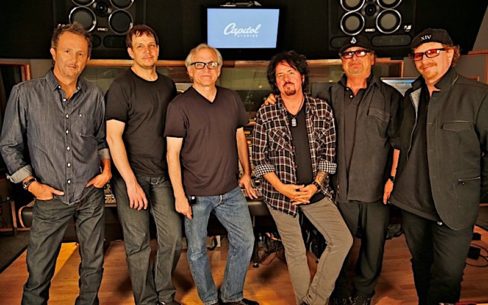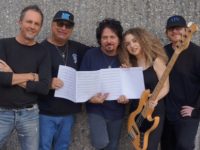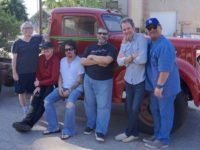Best known these days for his long association with Toto and Steve Lukather, CJ Vanston has worked as composer, producer, arranger and songwriter with Joe Cocker and Carrie Underwood, Def Leppard and Jennifer Lopez, Ringo Starr and Celine Dion, and Bob Seger and Dolly Parton, among others.
He’s toured with Tears for Fears, Tina Turner, Spinal Tap and Cocker, while also contributing to film scores including Waiting for Guffman, Best in Show and Almost Heroes. Co-musical director for the Muhammad Ali Humanitarian Awards since its inception in 2013, Vanston has written and performed original pieces for both Ali and the Dalai Lama.
Anthony Sonego followed up with Vanston after they began an on-line conversation about “20th Century Blues,” a standout track from 2015’s Toto XIV that took on new relevance in the wake of a violent attack against the U.S. Capitol on Jan. 6, 2021. This three-part Something Else! Sitdown kicks off with a look back at Vanston’s early days, collaborations with Richard Marx and how he first connected with Toto:

ANTHONY SONEGO: Can you tell me a bit about yourself and how you first got into music?
CJ VANSTON: I grew up in rural Michigan. My father was a jazz piano player and my mom and her entire family were musical. My parents split up when I was four years old, and my dad moved to an apartment above the stage where he performed to sold-out crowds. I stayed in the apartment and would put one ear to the floor and listen the glorious music literally right below me. On break, all the cats would come up and hang, I remember loving the way they laughed, how they dressed, how they laughed, and what a brotherhood they had. I remember some musicians from Stan Kenton’s band stopped by to hear my dad – Stan loved my dad’s playing – and came up to the apartment on break. I knew they were big shot musicians by the way they dressed and how my dad treated them. But then looked at them and thought: “This is bullshit. If they’re so successful, why do they have to share a cigarette?”
ANTHONY SONEGO: I know you started doing jingles in Chicago. Tell us about that type of work and how you transitioned into producing and arranging.
CJ VANSTON: Oh man, the jingle world could not have been a more perfect training ground for my entire studio career. I had studied classical music since the age of 10 and competed at a local level. Then cover bands out of high school, learning all the rich chords and parts to songs by classic bands like Steely Dan, Stevie Wonder, Toto, and Earth Wind and Fire. Also played in a jazz band, transcribing Charlie Parker stuff, Jaco Pastorius solos, never went to college, taught myself harmony and basic orchestration. My sight reading was very good from the classical training, and I was a natural at synthesizers and was lucky enough to make good enough bread playing clubs to buy a Minimoog, an Oberheim Four-Voice, and a couple of other items. So I was primed for the jingle scene. I moved to Chicago to join the progressive-rock band Trillion, but really wanted to become a studio musician. I quickly rose through the ranks of the Chicago players to become first-call keyboard player for most of the jingle houses there. My first gigs were with the top producers, right into the fire – and the king of them all was Dick Marx, Richard Marx’s father, a legend in Chicago.
Being first call meant that I was very busy, sometimes six or seven sessions a day. At 9 a.m., it would be a country feel, 10 a.m. a disco track, at noon with the Chicago Symphony for a big United Airlines fandango. What I’m getting to is that you had to play every style – and I got good at it. I got a Prophet VS and programmed the crap out of it, learned how to emulate just about any instrument. The money was insane – for that time – and the producers were unbelievably talented, some musical geniuses. What a training ground it was! One of the most important things it taught me was to be on time, and be prepared. When you had to spit out a track in an hour, there was no time to be late or fussing around with gear that didn’t work. You just didn’t get called back if that shit went down. At any rate, our core rhythm section was so good that everyone started hiring all of us on dates as a section. They called us the “Toto of Chicago”! Funny shit. As far as getting into producing and arranging, that would come later, when I moved to L.A. I did arrange a ton of jingles with no credit, and with some “producers,” I would take up the slack and take over interfacing with the musicians when the rare “business-minded” producer didn’t have the musical skill.
ANTHONY SONEGO: I guess Dick Marx provided your introduction to his son, Richard. What was it like working with Richard on “Right Here Waiting”? Do you have any stories from this era or lessons that stayed with you?
CJ VANSTON: Well, Richard had been doing vocals as a child singer on his father’s jingles for years. During my Chicago years, Richard was in his late teens and was doing sessions at night in his father’s studio, cutting songs he was writing. Very dedicated and focused. He ended up moving to L.A., and made a successful first album that got some attention. I heard that he was working on a new album and I told his dad: “I have to work on that record!” Dick called Richard and recommended me, to which Richard replied something like: “Dad, there’s a hundred good keyboard players out here – why would I need one from Chicago?!” Well, Dick talked Richard into trying me on something. I drove to Detroit to see him perform at Pine Knob, and then met him in the back of the tour bus to talk. He told me that he had a song that wasn’t going to go on the record, but he wanted to demo it up because he thought it might work in a film or something. I was disappointed to hear this, but then he played his demo. A light bulb went off, I knew exactly what to do with it, and told him so.
A few months later, Dick took me to lunch and told me that he was moving to L.A., and that it was my time to go also. He was so intuitive: I had been thinking the same thing, that I didn’t put in my 10,000 hours of getting good just to make the sound of shrimp flying through the air for Red Lobster jingles. I flew out to L.A. and immediately did the demo for “Right Here Waiting.” I didn’t put any drums on it, kept it small and intimate as opposed to what could have turned into a huge power ballad. That demo is basically what you hear on the finished record. I did all the instruments except Bruce Gaitch’s beautiful nylon guitar solo. Everybody flipped over the song, Richard put an amazing vocal on it. But still there was talk about it just being a movie song. Not sure what went down, but I know producer David Cole was a big champion for that song being on the album. Finally, it was decided that it was going to make the record. I jumped in and said, “Well, in that case it needs an intro.” David and Richard said: “No, it’s cool the way it is, and anyway there isn’t enough tape” – yes, tape – “at the head to record anything.”
I got up a beautiful pad using my Prophet VS, Roland Super Jupiter and D-50 and said: “Roll the tape from the top, and give me a signal when the header is done. [The header is the non-recordable white part at the beginning of a tape reel that’s used to thread through the machine.] David stared at the recorder and gave me a hand sign when the tape hit the heads and I improvised an intro. It was special and we all knew it. I got to the last chord and held it, not knowing when the track would come in, while we all stared at each other. Man, that track came in exactly where you would put it if you got a hundred stabs at it. The intro stayed; that’s what you hear on the radio. Richard told me, “You’re just the shot in the arm I needed,” and started handing songs to me to arrange. I ended up arranging most or all of that record. This meant cutting the basic tracks of course, something I had done hundreds of times – except now the band was Mike Landau, Lukather, John Robinson, Randy Jackson, Tom Scott, Dave Koz. I was finally in my element – and, of course, the synth overdubs were a breeze. Nobody could believe how fast I was at programming sounds and delivering take after take. Evidently the L.A. guys took way longer to get sounds, to the point that they would take a break or even have lunch while the guy dialed up sounds. My jingle experience paid off again: I learned to be quick and efficient in the studio, which saved the artist money and the producer his sanity.
One interesting note was that in my couple of years in cover bands, I was a stickler for everyone in the band learning the parts from the album. To make sure, I learned them all myself. I became consumed with Toto in particular. David Paich and Steve Porcaro were heroes to me. David could play all the cool bluesy/New Orleans piano stuff, not to mention his amazing parts that he patented. And on the other hand you had Steve P., who is an exceptional player in his own right, but was an absolute wizard at synthesizers and programming. I had always envisioned myself right smack in the middle of the two of them, and that’s kinda where I ended up. My point is that when I finally played with Luke, it was like two brothers. I knew him – and his keyboard players – musically so well.
ANTHONY SONEGO: After that, I’m guessing Richard wrote “Swear Your Love” for Luke’s debut album in 1989. What was your role on this track?
CJ VANSTON: Not sure how much I did on that track other than playing on it, but knowing me I’m sure I had a bunch of arrangement ideas. I’ll have to go back and listen to that! But this really sealed the beginning of a brotherhood with Luke. I’ll always be grateful to Richard for this.
ANTHONY SONEGO: So you hadn’t crossed paths when you moved out to L.A.?
CJ VANSTON: Had never met Luke until Richard’s album. Saw him play a few times live and was in awe. I had always done my version of synth guitar, one of my signatures, even did some Hendrix songs with just me, bass and drums. David Gilmour was always a huge influence, as was Luke. I love both of their melodic styles, with beautiful hanging long notes where other cats would spew diarrhea all over the track. So Luke and I share the same taste, very much musical brothers. Steve and I were born two weeks apart. One thing we’ve talked about is growing up in what we think – actually know, haha – was the richest possible time in modern music: Starting from watching the Beatles on Ed Sullivan to ’60s rock, and on to the glorious ’70s. Unbelievable. Stevie Wonder, Zeppelin, Weather Report, Yes, Zappa, ELP, Earth Wind and Fire, Deep Purple, Tull, Herbie, Queen, the Who, Chick Corea, Steely Dan, Bee Gees, Pink Floyd – I could go on and on. Oh, and that time period was the birth of the synthesizer. Couldn’t have been born at any better time.
ANTHONY SONEGO: One of my favorite albums from Toto is 1992’s Kingdom of Desire. When I saw your name on the track listing for “The Other Side” – a personal favorite – I knew you from Richard Marx as well as Luke’s debut solo album. I began to think, “Man, this CJ guy is doing great work.” Tell us more about that period.
CJ VANSTON: I knew I was firing on all cylinders. Word got out and I was working every day on records. I’d met Greg Ladanyi, the legendary engineer/producer. He’d mixed Toto IV, Don Henley’s Building The Perfect Beast, etc. We did a Dolly Parton album and soundtrack together that took a good six months. Could write a book just about that six months and working with the amazing Dolly Parton. During that time, Greg was also starting production on Toto’s new album. He talked me up to the cats and played some of the stuff I’d been doing for Dolly’s record, then I got the unlikely call to play on “The Other Side.”
ANTHONY SONEGO: What was that first session like?
CJ VANSTON: Well, it was surreal. First of all, I knew their music and their sounds inside and out. And as I said before, both David Paich and Steve Porcaro were huge influences. So to have both of them show up for the date was a trip. I mean I was more comfortable with Luke. We’d done a bunch of record dates together by then, but when the two keyboard giants showed up. Anyway, we went out to my setup in the live room. I had a huge rig back then, speakers and everything, and I played through some of my coolest sounds I’d prepared for their arrival. Dave said: “Wow, those are gorgeous sounds, but we want you to do your pedal-steel guitar.” I thought he was kidding. “Ladanyi played us a track where you did synth pedal steel – that’s what we want on the track.” Back when I played in clubs, I had gotten good at copping “real” instruments. I did a Stevie Wonder chromatic harmonica, bluegrass banjo, fretless bass solos – and yes, a pretty mean pedal-steel imitation. So that’s what I played on “The Other Side.”
Side note: A few weeks later, I got called by Don Was to play on a David Crosby record – my second with him. I walked in to the studio and there was Jeff’s drum set. I had to ask: “Are those Porcaro’s?” The second engineer confirmed yes. Gulp. I was on my first record date with Jeff. I played just piano – and Rhodes – on this date. Suddenly the studio door opened, and there stood Jeff f’ing Porcaro. He looked at me and said, “CJ fucking Vanston … let’s see what all the fuss is about!” Double gulp.
So back to the fact that I had schooled myself on all things Toto, and especially Paich’s groove: Jeff counted the song off and we instantly locked. It was a killer take, and Jeff was grinning, looking right at me with a badass jazz face as we carved. We finished the take and my heart was pounding. I knew I’d killed it and was waiting for Jeff’s reaction. He calmly spun around on his drum stool, lit up a cigarette, and walked right by me and out of the room without saying a word. What?! I sat at the piano trying to process why he’d blown me off. We’d had such an incredible first take our first time playing together. All of the sudden, the door to the studio opened and it was Jeff going “Bwaahahahahaha!” He ran over to me and gave me a huge bear hug and said: “Now, that was a groove!” We hung the rest of the day, played on another tune, talked about shit, then he gave me another hug and split. It was the last time I ever saw him.
- Toto, “Spanish Sea” from ‘Old Is New’ (2018): Toto Tuesdays - June 15, 2021
- Toto, “Devil’s Tower” from ‘Old Is New’ (2018): Toto Tuesdays - May 11, 2021
- Toto, “Alone” from ‘Old Is New’ (2018): Toto Tuesdays - April 27, 2021




